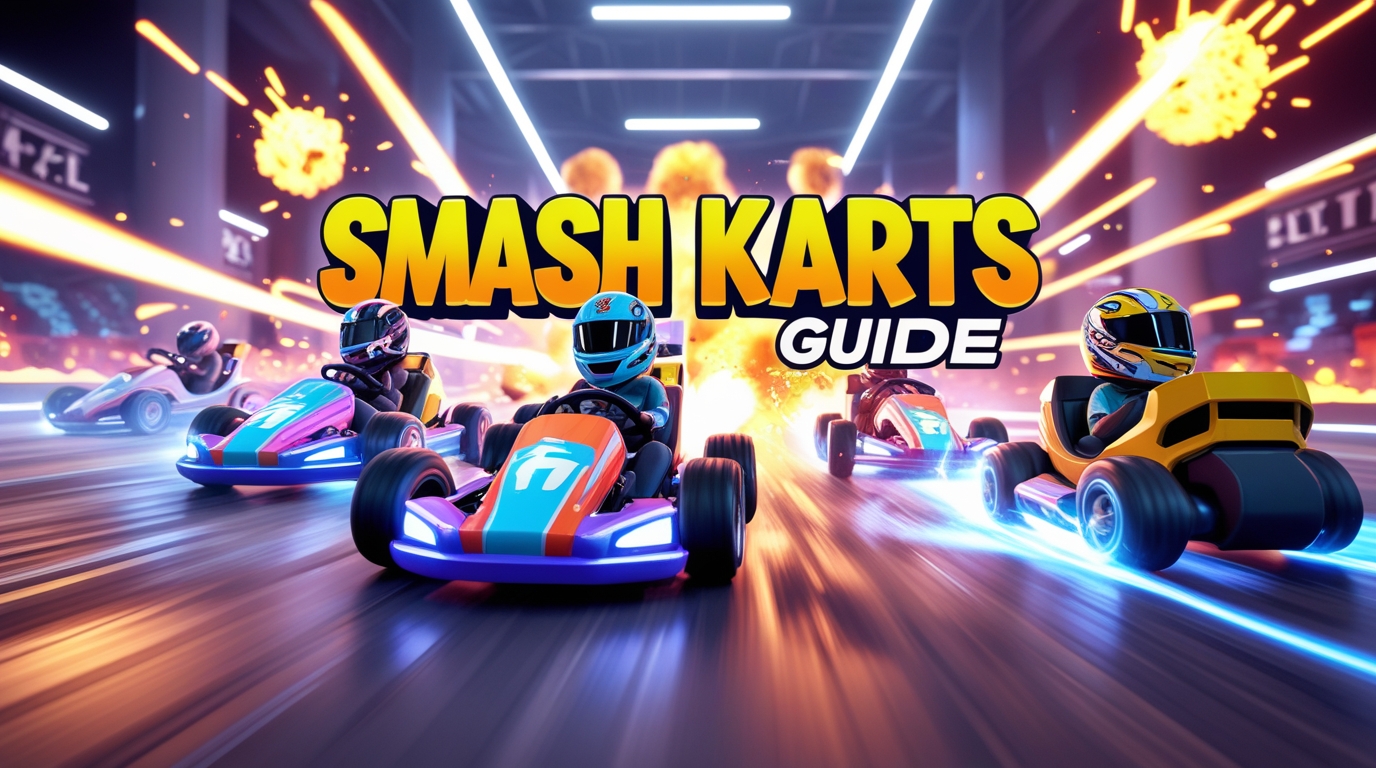Smash Karts — The Ultimate 2025 Guide: How to Play, Win, and Dominate the Lobbies

If you’ve been searching for Smash Karts, you’re probably after fast, chaotic kart battles with power-ups, wacky arenas, and frantic multiplayer mayhem. Smash Karts delivers exactly that: short, action-packed matches where driving skill matters, but improvisation and item play win the day. This guide covers everything U.S. players search for on Bing — how to get into the game, controls, maps, characters, power-ups, advanced strategies, unblocked browser options, performance tips, and a practical Q&A to answer all the common questions.

What is Smash Karts?
Smash Karts is a free-to-play arena kart battler that runs in browsers and on some casual game portals. Two to many players race in compact arenas, pick up random power-ups, and try to wreck opponents until they’re the last kart standing or have the highest score when time expires. Think chaotic kart racing crossed with a party brawler — short rounds, explosive items, and unpredictable outcomes.
Players love Smash Karts because it’s instant, easy to learn, and endlessly replayable. Matches are quick (often 3–5 minutes), so the game suits short breaks, parties, or casual streaming clips.
Where to Play (Platforms & Accessibility)
- Browser (HTML5/WebGL): The most common way to play. Works on Chrome, Edge, and Firefox. No download required.
- Game Portals: Popular portals (CrazyGames, Poki, CrazyGames-style sites) host Smash Karts versions. These pages often include leaderboards and room options.
- Unblocked Versions: Students often search “Smash Karts unblocked.” Some mirror sites or educational portals host browser-safe copies. Use only trusted sites — avoid downloads or sites asking for permissions.
- Mobile: Official mobile ports exist for some kart games, but Smash Karts is primarily a browser experience. Mobile play is possible via browser on modern phones, but controls and performance vary.
Game Modes & Match Types
Smash Karts offers a few common modes across versions:
- Free-for-All: Every kart for themselves. Most popular casual mode.
- Team Deathmatch: Teams of 2–4 try to rack up the most eliminations.
- Score Mode: Collect points by destroying opponents or picking up point orbs.
- Custom Rooms: Some portals allow private rooms with custom settings—great for friends or competitions.
Quick matches, no waiting — you spawn, pick an item, and the chaos begins.
Controls & Basic Mechanics
Controls are simple and consistent across most browser builds:
- Move / Steer: Arrow keys or WASD
- Boost / Use Item: Spacebar or a dedicated item key
- Brake / Reverse: S or Down Arrow
- Drift / Skill Move: Some versions use SHIFT or a second key to slide
- Mouse: Rarely required — mostly keyboard based
Core mechanics to master:
- Pickup Items: Drive over crates or orbs to get a random power-up.
- Use Items Smartly: Some are instant (rocks, bombs), others are aimed (missiles). Timing counts.
- Map Awareness: Know tight corners, hazards, and respawn points.
- Respawn: If destroyed, you’ll respawn after a short delay with temporary invulnerability in many versions.
Power-Ups & Items — What to Expect
Smash Karts thrives on wild, unpredictable items. Common ones include:
- Missiles / Rockets: Lock onto nearest opponent — dodgeable.
- Mines / Bombs: Drop and trap tight corridors.
- Shield / Invulnerability: Temporary defense against hits.
- Turbo / Speed Boost: Short but high-speed burst; risky in tight turns.
- Freeze / Slowdown: Handicaps opponents’ mobility.
- Laser / Railgun: High-precision long-range hit.
- Summonables: Temporary extra hazards or minions.
Learning each item’s window of effectiveness is a huge skill advantage. A poorly timed speed boost into a mine often equals self-elimination.
Best Maps & Map Strategies
Smash Karts maps are usually compact, with hazards, walls, ramps, and tight chokes.
- Small Arenas: Favor explosive items and close-quarters ambushes. Best to adopt hit-and-run play.
- Open Arenas: Speed and long-range items shine here; practice aiming missiles.
- Obstacle Fields: Use mines and traps to control lanes.
- Vertical Maps: Watch for fall zones and leverage boost timing.
Map awareness tip: If you’re ahead, avoid risky shortcuts. If behind, take high-risk routes — sometimes going for a bold play is the only path to comeback.
Characters & Skins
Many Smash Karts portals let you pick from a roster of karts or skins. These are usually cosmetic, but some versions offer minor stat differences (top speed vs. handling). Focus on:
- Handling: Easier to control, better for tight maps.
- Top Speed: Good for open maps and quick repositioning.
- Acceleration: Helps recover after hits.
For beginners, choose a kart with forgiving handling. Once you can control it reliably, experiment with faster karts for aggressive plays.
Advanced Tactics — How Pros Win
- Item Management: Don’t waste powerful items on easy targets. Hold a missile until a group clusters.
- Bait & Trap: Pretend vulnerability to lure opponents into mines.
- Corner Mastery: Drift into corners to maintain speed while avoiding walls.
- Spawn Camp Smartly: If you know respawn points, set traps to chain eliminations — but watch for team reprisals.
- Resource Control: Control item spawn areas; denying opponents items reduces their threat.
- Adapt to Meta: Some portals tweak item strength and spawn rates — stay updated.
Team Play & Communication
Team modes reward coordination:
- Callouts: Use quick voice or chat (if available) to flag incoming power-ups.
- Role Assignment: One player baits, another covers with rockets or mines.
- Sacrifice Plays: A skilled player might draw attention while teammates score points.
- Revive/Support: If a version has repair or resurrect mechanics, prioritize team sustain.
Good teams practice lane control and item trades rather than solo heroics.
Performance Tips & Troubleshooting
- Best Browser: Chrome or Edge for WebGL performance.
- Hardware Acceleration: Enable in browser settings.
- Close Tabs: Free up CPU/RAM by closing video streams and heavy tabs.
- Stable Internet: Lower ping = faster item responses. Use wired if possible.
- Clear Cache: If the game glitches, clear cache and reload.
- Lower Graphics: Some portals let you disable shadows or particle effects for smoother play.
If the game lags severely, try a different portal or a less crowded server. Some hosts throttle performance when many players join.
Safety & Fair Play (Unblocked Versions)
Students often look for “Smash Karts unblocked.” A few precautions:
- Use trusted portals rather than random mirror sites.
- Avoid downloading anything — legitimate browser versions don’t require installation.
- Don’t provide personal info or install extensions to “unlock” gameplay.
- Respect school/work rules; bypassing network blocks may violate policies.
If you host tournaments or custom rooms, enforce basic rules and mute toxic players.
Monetization — Is Smash Karts Pay-to-Win?
Most mainstream Smash Karts implementations are cosmetic-first. Some portals may push cosmetic skins or XP boosts, but true pay-to-win is rare. Still, check whether certain skins grant minor stat advantages — if they do, choose balanced lobbies or declare house rules for fair play.
Content Creation & Streaming
Smash Karts is great for short-form content:
- Highlight Clips: Explosive items, clutch comebacks, team wipeouts.
- Challenge Videos: No items, only mines, only rockets.
- Tutorials: Map guides, item uses, drift techniques.
- Live Tournaments: Quick viewer games make for engaging streams.
Keep clips snappy — most viewers enjoy 30–90 second funny moments.
Common Problems & Fixes
- Frequent Disconnects: Check network, try alternative server, or switch browser.
- Item Bug / Desync: Report to host; rejoin lobby.
- Room Not Filling: Create private lobby and invite friends; try peak hours for public matches.
- Blocked at School: Use approved educational gaming pages or play at home.
Also Read: Stickman Hook – A Complete 2025 Guide to Swinging, Skills & Tips
Frequently Asked Questions (Q&A)
Q1: Is Smash Karts free?
Yes. The browser versions are free to play. Some portals offer optional purchases for cosmetics or boosts.
Q2: Can I play Smash Karts on my Chromebook or school computer?
Yes — if the host site isn’t blocked. Use Chrome and make sure WebGL is enabled. Avoid installing extensions.
Q3: Are skins purely cosmetic?
Mostly yes. Check the specific portal for any stat differences; most hosts keep skins cosmetic.
Q4: How do I create a private room?
Look for a “Create Room” or “Private Lobby” button on the portal. Share the lobby code with friends.
Q5: Is there an official Smash Karts developer or multiple clones?
There are several versions and clones across game portals. Use trusted sites. Each host may have slightly different item lists or physics tuning.
Q6: Why does the game lag in big lobbies?
More players increase CPU and network load for the host. Try smaller lobbies or lower graphics settings.
Q7: Are there cheats or hacks?
Cheats can harm fair play and may carry malware. Avoid hacks and report suspicious sites.
Q8: What’s the best way to learn items?
Play casual matches and deliberately test each item in private lobbies to learn range, timing, and counterplay.
Q9: How do tournaments work?
Simple formats: single elimination with best-of-three matches or point leaderboards across rounds. Use private rooms to manage matches smoothly.
Q10: Any pro gear recommendations?
A mechanical keyboard with responsive keys helps, and a wired connection reduces ping. Controllers are less common for browser karters.
Final Thoughts
Smash Karts is pure, unpretentious fun — short matches, explosive items, and a hospital-ward of hilarious moments every round. The best players mix good driving fundamentals with smart item usage and map control. If you’re getting started, play free-for-all to learn items; once comfortable, jump into team matches and private rooms to hone coordination.


